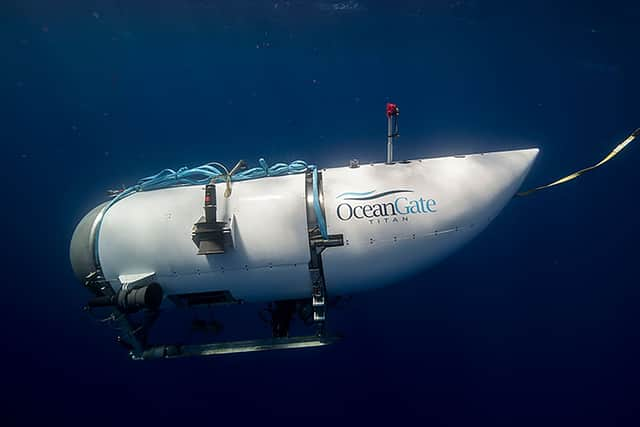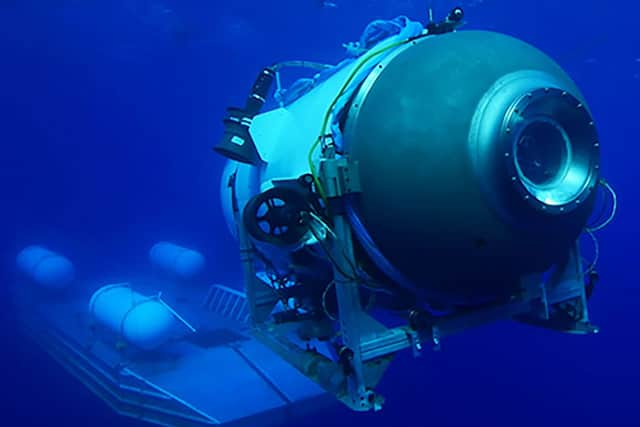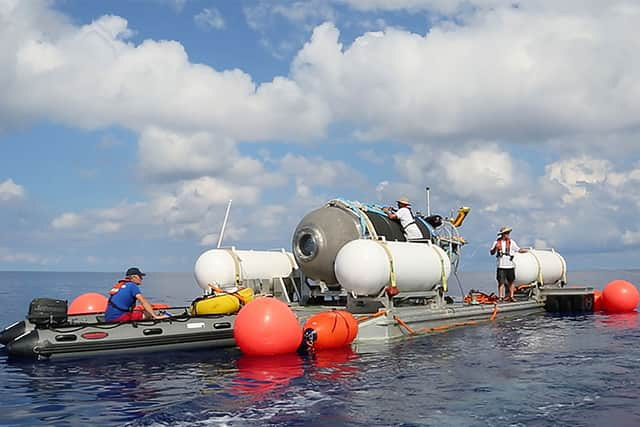Missing Titanic submarine: debris found near shipwreck part of missing sub - Coast Guard confirms
and live on Freeview channel 276
Parts of the missing Titan submersible were found close to the wreck of the Titanic, the US Coast Guard says, “consistent with a catastrophic loss of the pressure chamber”.
The submersible - named Titan - lost communication with tour operators on Sunday (18 June) while about 435 miles south of St John’s, Newfoundland, during a voyage to the Titanic shipwreck off the coast of Canada. Hopes have been fading for the five passengers after the clock ran out on the 96 hours of oxygen believed to be onboard on Thursday morning (22 June).
Advertisement
Hide AdAdvertisement
Hide AdOn Thursday evening, the US Coast Guard announced that a remotely-operated vehicle from the Canadian Horizon Arctic ship had discovered debris on the sea floor, near the Titanic ruins.
Rear Admiral John Mauger said in a press conference it had found the tail cone of the Titan on the sea floor - nearly 200 metres from the bow of the Titanic - as well as other debris from the vessel nearby.
"In consultation with experts from within the unified command, the debris is consistent with the catastrophic loss of the pressure chamber," he said. "Upon this determination, we immediately notified the families.
“On behalf of the United States Coast Guard and the entire unified command, I offer my deepest condolences to the families. I can only imagine what this has been like for them." He added: "I hope that this discovery provides some solace during this difficult time.”
Advertisement
Hide AdAdvertisement
Hide Ad

On Wednesday afternoon, the US Coast Guard warning the vessel would run out of breathable air at around 10am GMT on Thursday (22 June) - 11am in the UK. Aircraft, ships, and other equipment was scrambling to help find the missing deep-sea vessel throughout Thursday, with the US Coast Guard saying the French ship L’Atalante was preparing its specialist Victor 6000 ROV, which has a capacity to lift the Titan ship to the surface, to enter the water.
Meanwhile, the Canadian vessel Horizon Arctic’s ROV had reached the sea floor - where it discovered the debris field.
He told Sky News at the time: “We continue to keep the crew members and the families in our thoughts as we proceed with this search and rescue while we’re cognisant of the time and we’ve factored in a lot of data and information into the search.
“This is still an active search and rescue at this point and we’re using the equipment that we have on the bottom right now, the remote operated vehicles to expand our search capability, and then also to provide rescue capability as well.”
Advertisement
Hide AdAdvertisement
Hide AdThe 6.7m (22ft)-long OceanGate Expeditions vessel has five people on board, including British billionaire adventurer Hamish Harding, UK-based businessman Shahzada Dawood, his son Suleman Dawood, and OceanGate’s chief executive and founder Stockton Rush, reportedly with French submersible pilot Paul-Henri Nargeolet.
Experts are now saying the chances of finding the sub and rescuing those inside is diminishing. Former Royal Navy submarine captain Ryan Ramsey told the PA news agency: “The outlook is bleak, that’s the only word for it as this tragic event unfolds and almost the closing stages of where this changes from rescue to a salvage mission.”
Meanwhile, Dr Jamie Pringle, a reader in Forensic Geosciences at Keele University, added: “I think there’s always hope with these things but you know about the golden first 24 hours and we’re well past that stage. So there’s always a chance, it’s never zero, but I think obviously the longer the time elapses the lower the chance of success.”


The US Coast Guard has been leading an international rescue effort which was stepped up after underwater banging noises were heard on Tuesday and again on Wednesday, although experts have been unable to determine the cause of the sound.
Advertisement
Hide AdAdvertisement
Hide AdThe area of the search has also been expanded, with the surface search now about 10,000 square miles, and the sub-surface search about 2.5 miles deep. The coast guard had five surface vessels searching for Titan on Wednesday and they expected there to be 10 by Thursday.
When questioned about the noises detected by the sonar buoys dropped into the ocean, Admiral Mauger revealed initial reports found that it was “ocean background noise”. He said: “We’ve taken that information and shared it with top leading experts from the US Navy and the Canadian Navy, and they’re working on the analysis of that information, they’re continuing to work on the analysis of that information.
“The initial reports is that there’s a lot of the sounds that were generated were from background ocean noise, but they continue to … look for all available information there. What’s important to me, and what’s important as the unified command, is that we’ve continued search in the areas where noise was detected with the ROVs that we have from the time of that detection, so we’re not waiting for this analysis to take action.
“The analysis is really helpful to our overall search-and-rescue efforts, but we’re not waiting on it, we’ve moved the remote operated vehicles that we’ve had on site to those areas where noise was detected.”
Advertisement
Hide AdAdvertisement
Hide Ad

Deep-sea explorer Dr David Gallo believes it would take a “miracle” to rescue those trapped in Titan and warned it will take hours to rescue the submersible once found. Speaking to Good Morning Britain, he said: “In this case, the noises are repetitive, every half hour I believe.
“Three different aircraft heard them in their sensors at the same time and it went on for two days-plus. It’s still going on apparently. There’s not a lot in the natural world we can think of that would do that every 30-minute cycle.
“We have to, at this point, assume that that’s the submarine and move quickly to that spot, locate it and get robots down there to verify that is where the submarine is. They’ve got to go fully ready as if that was the sub because it takes a while to locate it and get it up to the surface, it takes hours.”
Captain Frederick added: “What I can tell you is, we’re searching in the area where the noises were detected, and we’ll continue to do so and we hope that when we’re able to get additional ROVs (remotely operated vehicles) which will be there in the morning, the intent will be to continue to search in those areas where the noises were detected, and if they’re continuing to be detected, and then put additional ROVs down on the last known position where the search was originally taking place.”
Advertisement
Hide AdAdvertisement
Hide AdAsked whether the mission was changing to become a recovery search, he said: “This is a search and rescue mission 100%, we are smack dab in the middle of search and rescue and will continue to put every available asset that we have in an effort to find the Titan and the crew members.”
Questions have been raised about the safety of the vessel after it emerged earlier this week that a former employee of OceanGate had previously raised concerns over “safety and quality control issues regarding the Titan to OceanGate executive management”.
David Lochridge, OceanGate’s former director of marine operations, claimed in an August 2018 court document that he was wrongfully fired after flagging worries about the company’s alleged “refusal to conduct critical, non-destructive testing of the experimental design”.
Sean Leet, co-founder and chairman of Horizon Maritime Services, which owns the Polar Prince mothership from which Titan launched, defended the company at a separate press conference on Wednesday. He said: “OceanGate runs an extremely safe operation. Our full focus right now is getting that submersible located and getting those people brought back safely.”
Comment Guidelines
National World encourages reader discussion on our stories. User feedback, insights and back-and-forth exchanges add a rich layer of context to reporting. Please review our Community Guidelines before commenting.